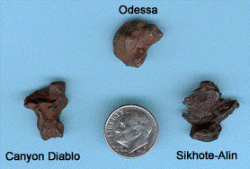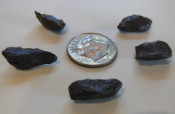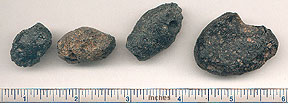 |
Listed below are a variety of Meteorites and uniquely formed Tektites. |
CANYON DIABLO METEORITES - Meteorites are rocks from outer space. The iron type meteorites shown below are classified as IA, coarse octahedrites. The origin of Canyon Diablo meteorites is the most famous impact crater in the world: Meteor Crator, Arizona. Located in northern Arizona near the city of Winslow; Meteor Crater is about 30,0000 years old.
These iron meteorites are characterized by classic meteorite features like thumb-printing, sharp ridges, holes and bowls. Many contain inclusions of graphite. When a graphite inclusion pops out of the host meteorite it is called a graphite nodule. Another interesting fact about Canyon Diablo is the occurrences of carbonados or black diamonds formed by impact on earth or in space.
| Product (hover for detail) |
Item # | Item Description | Price | ||
|---|---|---|---|---|---|
MC4a |
Canyon Diablo - Each meteorite is a unique piece that come in a variety of shapes and sizes. Canyon Diable Meteorites:
|
|
ODESSA METEORITES The Odessa meteorite is iron-nickel Group I, coarse octahedrites. The Odessa crater, near Odessa, Texas was discovered in 1920. The crater and the meteorites found in it were first described in 1922 by Daniel Barringer.
The Odessa crater is approximately 500 feet in diameter, about 6 feet deep, with its rim rising about 6 feet above the surrounding plain. The crater is filled with about 30 feet of sand. Drilling attempts to locate any large, surviving meteorite(s) in the main crater, along with 4 surrounding smaller craters did not prove successful. This has lead some to believe that the main body of the meteorite probably vaporized on impact.
| Product (hover for detail) |
Item # | Item Description | Price |
|---|---|---|---|
MO4c MO4d |
Odessa - Each meteorite is a unique piece that come in a variety of shapes and sizes. We have two sizes of Odessa Meteorites:
|
SIKHOTE-ALIN METEORITE SHRAPNEL The Sikhote-Alin meteorite fell in the Maritime Territory, Federated SSR, USSR on February 12, 1947. The total known weight was over 25 short tons (23,000 kg). The fall of this iron meteorite produced 106 impact holes up to 92 feet in diameter over an area of 328 ft x 2165 ft in the thick forest of the Sikhote-Alin Mountains. Many fragments weighing up to 660 pounds in weight have been recovered.
When a very large meteorite hits the earth it can explode into thousands of smaller pieces. This happened with some of the largest masses of the Sikhote-Alin fall. These pieces of torn and twisted nickel-iron metal were ripped apart by tremendous force when the comic body hit the Earth. They are called shrapnel fragments because they look very much like the twisted metal of a bomb explosion. However, they still preserve characteristics of their meteorite nature in the way they have cracked and torn.
| Product (hover for detail) |
Item # | Item Description | Price |
|---|---|---|---|
MS4a MS4b MS4c |
Siknote-Alin Shrapnel - Each shrapnel is a unique piece that come in a variety of shapes and sizes. We offer three sizes of Sikhote-Alin Shrapnel:
|
HENBURY METEORITES The Henbury meteorite fall was discovered in 1931. The largest of the Henbury meteorite craters is about 590 feet wide and 49 feet deep. It is located about 87 miles south of Alice Springs in Central Australia. The craters were formed by several meteor impacts around 4700 years ago. Twelve craters have been identified, some not more than 20 feet wide and an inch deep. These iron meteorites are composed primarily of various alloys of iron and nickel. Structural class is medium Octahedrites (IIIAB)
| Product (hover for detail) |
Item # | Item Description | Price |
|---|---|---|---|
MH4a MH4b MH4c MH4d |
Henbury - Each meteorite is a unique piece that come in a variety of shapes and sizes. We offer four sizes of Henbury Meteorites:
|
TEKTITES are small pieces of silica-rich (usually 65-80% SiO2) glass found in limited areas in a few regions on the Earth's surface. They are similar in composition and appearance to volcanic glass such as obsidian with colors generally ranging from black to green. Formed under somewhat mysterious conditions that preclude a volcanic (terrestrial) origin, F.E. Suess (who introduced the name tektite in 1900) considered them to be glassy meteorites. However, unlike other meteorite types, tektites have not been seen to fall from the sky.
There are two current theories as to the origin of tektites. Both agree that the production of the molten silicate needed to form a tektite is the result of the impact of comets or large meteorites. Tektites are formed when a comet or meteorite collides with the earth - or moon - with such force that melted rock is "splattered" into the upper atmosphere. Here the droplets cool and harden into the shiny glassy shapes we call tektites.
The specimens offered below are Indochinite Tektites which are 70-80% SiO2. Indochinite tektites are the best known of the tektites coming from the Paulin District of Thailand. They are the classic teardrop and cigar shapes found in rice paddies throughout southeast Asia in Thailand, Laos and Vietnam. Tektites are generally found in strewn fields that are sometimes thousands of miles across.
| Product (hover for detail) |
Item # | Item Description | Price |
|---|---|---|---|
S405a S405b |
Indochinite Tektite - Each tektite is a unique piece that come in a variety of shapes and sizes. We offer two sizes of Indochinite Tektites:
|
MOLDAVITE TEKTITES We also have some Czechoslovakian Tektites which are the result of a meteor strike nearly 15 million years ago. This collision between a meteor and the Earth occurred in the Moldau River Valley in what is now the Czech Republic. These green gems are among the rarest minerals on earth. The color varies from a gray green to an emerald green. They can be carved with diamond cutting tools into various shapes and forms. Moldavites are claimed to have mystical qualities.
| Product (hover for detail) |
Item # | Item Description | Price | ||
|---|---|---|---|---|---|
S406 |
Moldavite Tektite - These Moldavites are approximately 0.5 inches+ in size and come in various shapes. Nice specimens for your collection. |
|








